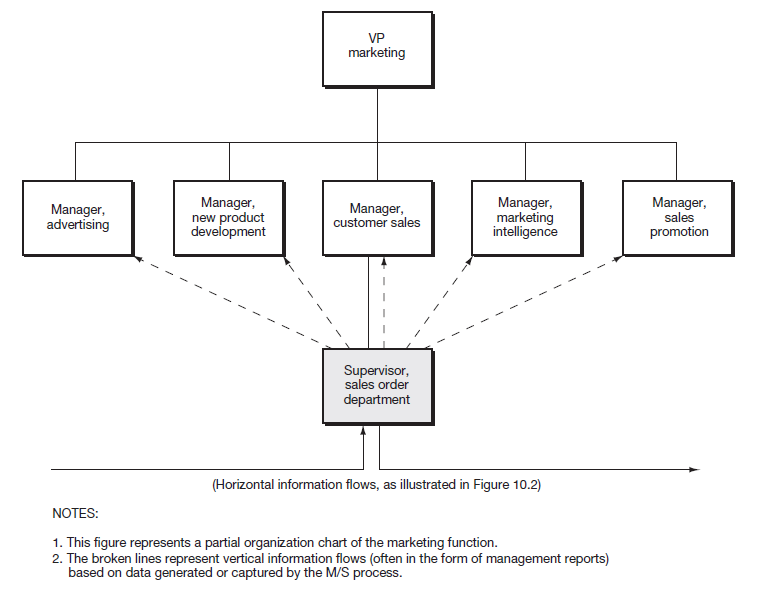To understand the relationship between the M/S process and managerial decision making, you need to become familiar with the key players involved in the marketing function. Figure 11.3 presents these players in the form of an organization chart.
TECHNOLOGY INSIGHT 10.1
Enterprise System Support for Horizontal Information Flows
The information flows presented in Figure 11.2 are very similar to what we would expect when an organization uses an enterprise system. However, many of the tasks outlined could occur quite differently because of the messaging capabilities embedded in contemporary enterprise systems. Let us take another look at each of the information flows in Figure 11.2.
- The customer places the order (While this could be done electronically over the Internet, we will assume for now it is placed as in the system discussed in this chapter.)
- Because the sales order department requires credit approval from the credit department, the approval process is automatically incorporated into the routing set-up within the enterprise system. Hence, once the sales order department releases the order to credit approval, the document is automatically routed electronically to the credit department and queued for their approval.
- The credit department’s approval requires a few simple data entry steps and the approval is automatically routed electronically back to the sales order department by the enterprise system. [This step assumes that the order requires a manual credit approval. If the credit-approval rules can be programmed (or configured) into the system, the entire credit approval would be performed by the enterprise system.]
- The sales order department’s response to the customer is also automatically triggered by the enterprise system in most implementations. This response may be electronic or may still be paper-based as in traditional systems.
- The routing to the shipping department is very likely triggered by the enterprise system simultaneously with customer notification and likely not to require any additional entry by the sales order department beyond that entered to trigger information flow #4.
- Similarly, routings to the warehouse, payroll, revenue collection, and general ledger are also more than likely triggered by the same action as that in flows #4 and #5.
- Once the warehouse has completed picking the order, the information is entered into the system to reflect that the goods have been picked and are ready for shipment. Should the sales order department receive any inquiries from the customer, it can tell the customer that the goods have been picked and await shipment.
- Once the shipping department releases the shipment, the information is entered into the enterprise system at the shipping location to record the order as shipped. Should the sales order department receive any inquiries from the customer, it can tell the customer that the goods have been shipped.
- Similarly, the carrier and the billing personnel may inquire about the status of the order.
As demonstrated in this overlay to the M/S process, an enterprise system may not change many of the workings of the business process but, rather, removes much of the wasteful time and paper shuffling that takes place in traditional systems, incorporating electronic messaging systems that speed notifications. Also, the use of automated triggers ensures that various steps in the process will not be omitted, as the system requires each process activity to be completed before triggering the next process activity.
As the figure illustrates, sales-related data are captured in the sales order department and then flow upward (in a summarized format) to managers housed within the marketing organizational structure. Much of this information would be based traditionally on sales-related events and normally would be captured through the use of a sales order form or through entry of data directly into a computer database. As organizations become ever increasingly focused on customers, however, the information needed for decision making is less focused on executing and recording the sale and more on customer characteristics, needs, and preferences. The next section provides an overview of the relationship between management decision making and the M/S process, and how information technology facilitates these demands of decision makers.

|
Review Question What key players would you expect to find in the marketing function’s organization chart? |
- 5812 reads






